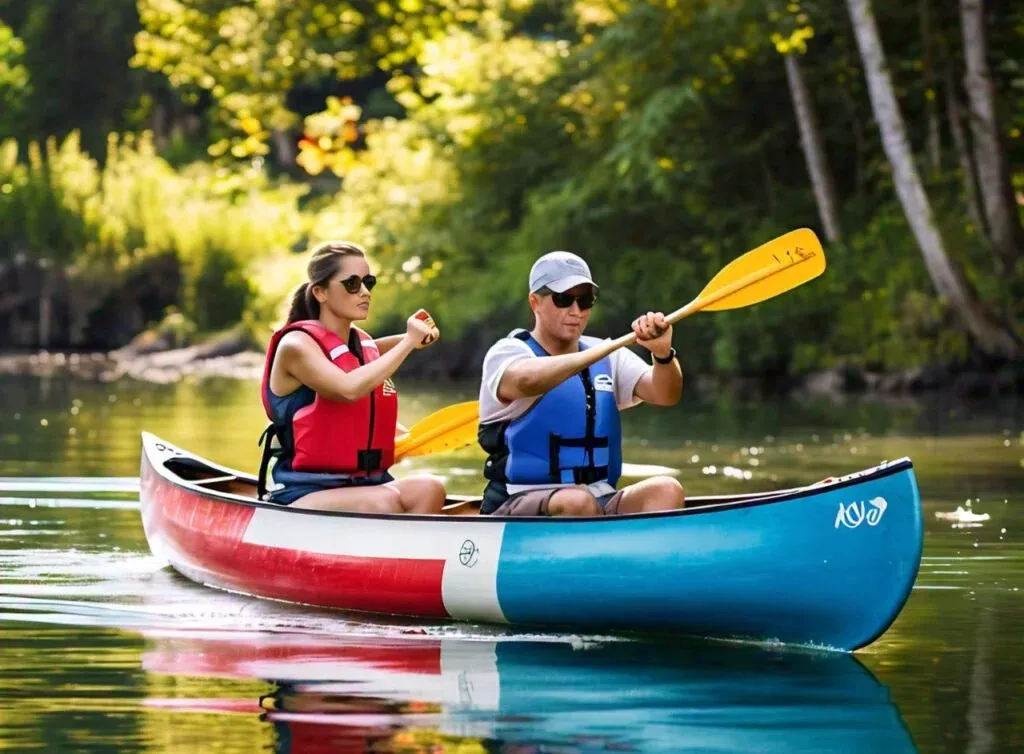
Tandem canoes offer a fantastic way to explore the waterways with a partner. Whether you’re an experienced paddler or new to canoeing, tandem canoes offer stability, capability, and the joy of sharing experiences. In this guide, we’ll cover everything about tandem canoes, including types, benefits, how to choose the right one and essential maintenance tips.
What is a Tandem Canoe?
A tandem canoe is designed so that two people can paddle together. These canoes are typically longer and wider than single canoes, providing greater stability and space for equipment. Tandem canoes are ideal for family outings, fishing trips, and extended paddling adventures.
Benefits of Tandem Canoes
1. Shared experience
Tandem canoeing allows you to share the canoeing experience with a friend or family member. It’s a great way to bond and work together while enjoying nature.
2. Greater stability
The wider design of tandem canoes provides greater stability, making them less likely to capsize. This makes them ideal for beginners and those carrying additional equipment.
3. Greater capacity
With two paddlers, tandem canoes can carry more weight, including camping gear, fishing gear, or a picnic basket. This makes them perfect for long trips or family outings.
4. Row efficiently
Two people paddling in sync can efficiently move a tandem canoe through the water. This can cover greater distances more quickly than a solo canoe.
Types of Tandem Canoes
1. Recreational tandem canoes
Recreational tandem canoes are designed for relaxed paddling on calm waters. They are stable, easy to maneuver, and ideal for short trips and beginners.
2. Tandem canoes on tour
Tandem touring canoes are built for paddling long distances in a variety of water conditions. They offer better performance, speed, and tracking, making them suitable for experienced paddlers.
3. Tandem whitewater canoes
Tandem whitewater canoes are designed to meet the challenges of fast rivers and rapids. They are sturdy, durable, and provide excellent control in turbulent conditions.
4. Tandem fishing canoes
Tandem fishing canoes come with angler-friendly features like rod holders, storage compartments, and stable platforms for casting and reeling fish.
How to Choose the Right Tandem Canoe
Consider your paddling style
Think about how and where you plan to use your tandem canoe. Your paddling style and preferred water conditions will influence the type of canoe that best suits your needs.
Evaluate materials and construction.
Tandem canoes come in a variety of materials, including aluminum, fiberglass, Kevlar, and polyethylene. Each material has its advantages and disadvantages, affecting the weight, durability, and performance of the canoe.
Evaluate stability and comfort.
Look for a canoe that offers good stability, especially if you are a beginner. Comfortable seats and ample legroom are also important for long boat trips.
Check capacity and storage
Make sure the canoe has enough capacity to carry your equipment and supplies. Storage compartments and tie-down points can be useful for securing your items during your trip.
Budget considerations
Tandem canoes come in a variety of prices. Set a budget and look for a canoe that offers the best value for money without compromising quality and performance.
Essential Gear for Tandem Canoeing
Oars
Choose paddles of the right length and weight for your canoe and paddling style. Lightweight carbon fiber or fiberglass paddles are popular options.
Lifevest
Life jackets are a fundamental safety element for any paddler. Make sure they fit well and are comfortable to wear for long periods.
dry bags
Dry bags are essential for keeping your belongings safe and dry. They come in different sizes and are perfect for storing clothes, electronics, and other equipment.
First aid box
Always carry a basic first aid kit to treat minor injuries or emergencies while on the water.
Navigation tools
Carry a map, compass, or GPS device to help you navigate unfamiliar waters and stay on track.
Maintenance Tips for Tandem Canoes
To keep your tandem canoe in tip-top condition, regular maintenance is essential. Here are a few tips:
Clean after each use
Rinse your canoe with fresh water after each use to remove dirt, debris, and any saltwater residue that could cause damage.
Inspect for damage
Check your canoe periodically for cracks, dents, or other signs of wear. Address any issues quickly to prevent them from getting worse.
Store correctly
Store your canoe in a cool, dry place out of direct sunlight. Use a cover to protect it from dust and UV rays.
Tighten loose hardware
Periodically check and tighten any loose screws, bolts, or hardware to ensure your canoe remains in good working order.
Paddling Tips for Tandem Canoeing
Communication is key
Effective communication between paddlers is crucial in tandem canoeing. Agree on paddling rhythm, turns, and orders before setting off.
Row in sync
To move efficiently, paddlers must synchronize their movements. This not only improves speed but also keeps the canoe in a straight line.
Understand everyone’s roles
Typically, the stern paddler (stern) steers the canoe, while the front paddler (bow) provides power and assistance with navigation. Understanding these roles can make paddling more effective.
It is a practice that makes perfect.
Spend time practicing different rowing maneuvers and techniques. The more you paddle together, the better you will master the canoe.
Conclusion
Tandem canoes offer a wonderful way to explore the water with a partner. With the right canoe and equipment, you can experience countless adventures and create lasting memories. By understanding the different types of tandem canoes, considering your needs, and properly maintaining your canoe, you can ensure many enjoyable canoe trips.
FAQs
1. What is the best material for a tandem canoe?
The best material depends on your needs. Kevlar and carbon fiber are lightweight and durable, while polyethylene is more affordable and robust.
2. How do I choose the right paddle for my tandem canoe?
Choose paddles that match your height and paddling style. Lightweight paddles made from carbon fiber or fiberglass are ideal for long trips.
3. Can I use a tandem canoe for fishing?
Yes, fishing tandem canoes come with features like rod holders and stable platforms, making them ideal for anglers.
4. How do I transport a tandem canoe?
Tandem canoes are lightweight and easy to transport. Use a roof rack or trailer designed for canoes to safely transport your canoe.
5. What should I do if my canoe gets damaged?
Inspect your canoe regularly for damage. If you find any cracks or dents, repair them promptly using appropriate materials and techniques.
 The Boat Journey
The Boat Journey
Leave a Reply